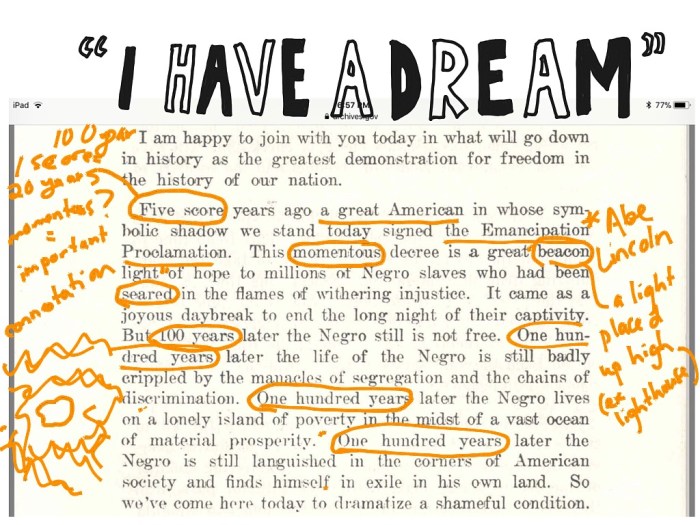Alliteration in i have a dream speech – Alliteration in “I Have a Dream” speech, a powerful rhetorical device, enhances the speech’s meaning, rhythm, and emotional impact. This literary technique, skillfully employed by Dr. Martin Luther King Jr., elevates the speech to a timeless masterpiece.
The alliteration in the speech contributes significantly to its rhythm and cadence, making it more memorable and impactful. It creates a musicality that captivates the audience, reinforcing the message and leaving a lasting impression.
Alliteration in “I Have a Dream” Speech: Alliteration In I Have A Dream Speech

Alliteration, the repetition of consonant sounds at the beginning of words, is a literary device used extensively in Dr. Martin Luther King Jr.’s iconic “I Have a Dream” speech. It contributes to the speech’s powerful and memorable language, enhancing its meaning, rhythm, and overall effectiveness.
Key Examples of Alliteration
- “Let freedom ring”
- “With this faith, we will be able to hew out of the mountain of despair a stone of hope”
- “I have a dream that one day this nation will rise up and live out the true meaning of its creed: ‘We hold these truths to be self-evident, that all men are created equal'”
Impact of Alliteration on Meaning
Alliteration emphasizes key words and phrases, drawing attention to their significance. It creates a sense of urgency and importance, reinforcing the speaker’s message. In King’s speech, the repetition of “d” in “dream” and “despair” highlights the contrast between the aspiration for freedom and the current reality of oppression.
Emotional Impact of Alliteration
Alliteration can evoke strong emotions in listeners. It creates a sense of rhythm and flow, making the speech more engaging and memorable. The repetition of consonant sounds mimics the heartbeat, creating a visceral connection with the audience. King’s use of alliteration, such as “with this faith, we will be able to hew,” conveys a sense of determination and hope.
Alliteration and Rhythm
Alliteration contributes to the speech’s rhythm and cadence. It creates a sense of movement and energy, propelling the speech forward. The repetition of consonant sounds creates a beat that helps listeners follow the flow of the speech and retain its message.
King’s use of alliteration, such as “rise up and live out,” enhances the speech’s delivery and makes it easier to memorize.
Comparison to Other Speeches, Alliteration in i have a dream speech
Alliteration is a common device in famous speeches. However, King’s use of alliteration in “I Have a Dream” stands out for its frequency and effectiveness. Compared to other speeches, such as Winston Churchill’s “Blood, Toil, Tears, and Sweat” or Abraham Lincoln’s “Gettysburg Address,” King’s speech exhibits a more consistent and deliberate use of alliteration throughout.
Literary Significance
Alliteration contributes to the literary significance of “I Have a Dream.” It elevates the speech from a political address to a work of art. The use of alliteration adds a layer of beauty and complexity to the language, making it more aesthetically pleasing and memorable.
King’s speech is widely recognized as a masterpiece of American literature, and its use of alliteration is a significant factor in its literary value.
Symbolism and Imagery
Alliteration can create powerful symbolism and imagery. In King’s speech, the repetition of “d” in “dream” and “despair” symbolizes the struggle between hope and despair. The repetition of “h” in “hope” and “history” evokes a sense of progress and inevitability.
Alliteration enhances the speech’s metaphorical and allegorical meanings, making it more resonant and impactful.
Historical Context
The use of alliteration in “I Have a Dream” reflects the social and political climate of the time. The speech was delivered during the Civil Rights Movement, a period of intense struggle for racial equality. King’s use of alliteration helped to galvanize the movement and inspire hope in a time of great uncertainty.
Audience Response
The audience’s response to King’s use of alliteration was overwhelmingly positive. It contributed to the speech’s emotional impact and made it more memorable. The repetition of consonant sounds created a sense of unity and purpose among the listeners, reinforcing the message of hope and equality.
Essential FAQs
What is the significance of alliteration in “I Have a Dream” speech?
Alliteration contributes to the speech’s meaning, rhythm, emotional impact, and literary significance.
How does alliteration enhance the rhythm of the speech?
Alliteration creates a musicality that reinforces the message and leaves a lasting impression.
What is the historical context of the speech?
The speech was delivered during the Civil Rights Movement, reflecting the social and political climate of the time.

